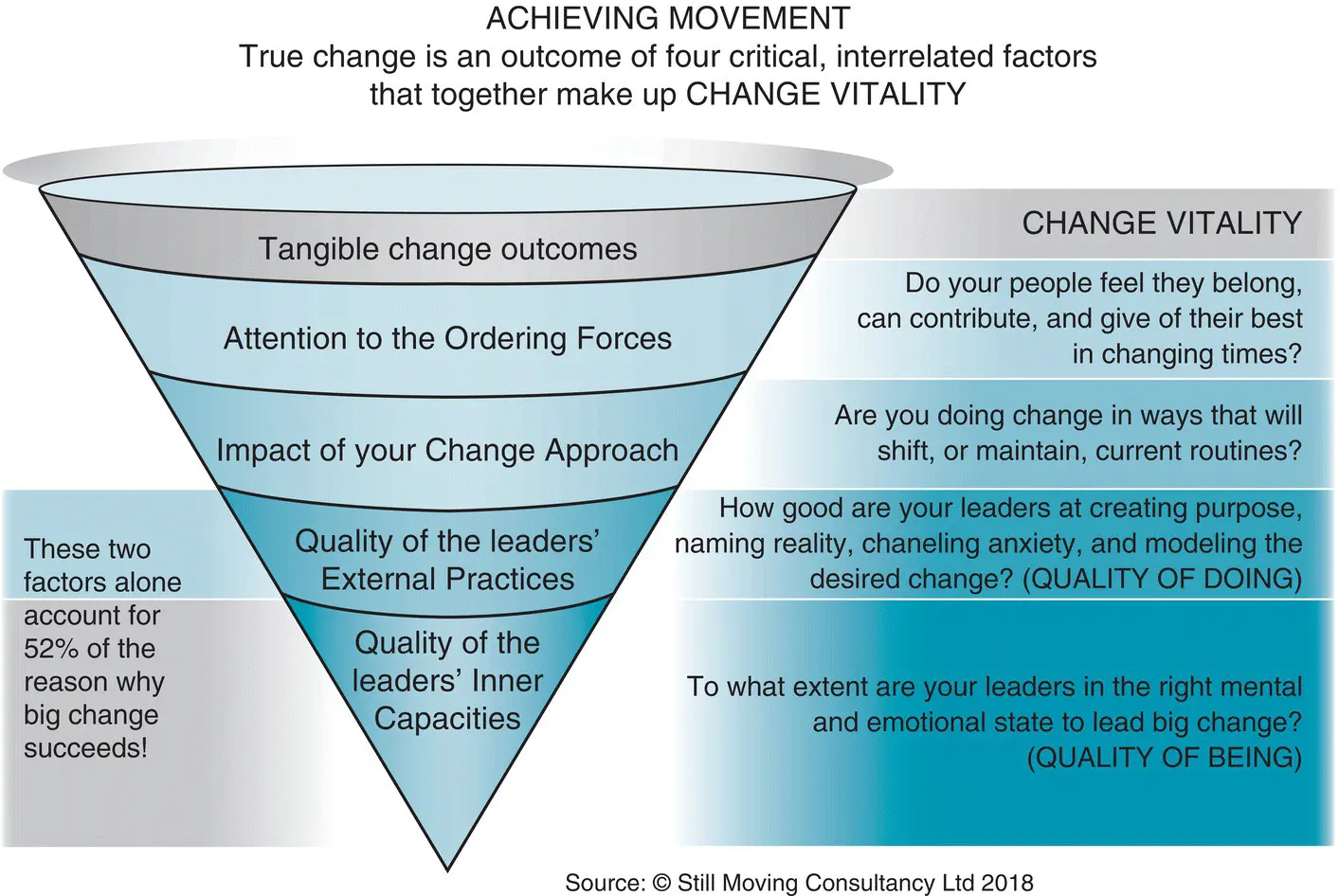Change Vitality is therefore a call to a new “how” of leading change. It is made up of four interconnected capacities, or Factors, which in combination lead to movement—that is, tangible change outcomes—and not just busy action, the repetition of past routines.
The four Factors are:
The Inner Capacities—the quality of your inner state as a leader, how people experience your “being”
The External Practices—the effectiveness of your outer behavior, what people can see you “doing”
The Change Approach—how you choose overall to implement change across the system that you lead
The Ordering Forces—the quality of the overall systemic health of your organization that impacts if your change effort will flow with ease or get stuck

We visualize these four Factors as a flow of energy that rises upward through the spinning Change Vitality cone. Sometimes, change can feel a bit like this! A bit wobbly, risky, hard to stay in balance. And, we all know that the essence of a cone's ability to move at pace, yet remain stable, rests on how it pivots on the ground.
That is why we start from the quality of a leader's internal state, their Inner Capacities, and work upward. The entire quality of your ability to lead the swirl of today's change well starts here: in stillness, with your ability to both notice and regulate your inner mental and emotional response to experience. When you can do this, you will perceive and receive the external world more clearly, and therefore take more appropriate action. We call this being before doing .
However, it does not stop at your personal leadership, as we also know that the successful leadership of change requires attending to factors at the whole‐system level. And here we have the final two Change Vitality Factors: your choice of overall Change Approach (top down vs. decentralized, programmatic vs. emergent) and how well you attend to the vital Ordering Forces that govern the flow of relational energy in all human systems. Ignore both of these systemic Factors at your peril.
What Change Vitality Comprises—in More Detail
Each of these four Change Vitality Factors breaks down into individual Elements—as seen in this list. Most of these Elements are promoters of change success: we found them highly correlated with the ability to lead complex change well. Some of them are detractors of change success: we found them to be highly negatively correlated with successful change. In total, there are 19 separate Elements.
| Change Vitality Overall Factor |
Change Vitality Individual Elements |
| Inner CapacitiesThe quality of your “being” |
Staying Present |
| Curious and Intentional Responding |
| Tuning into the System |
| Acknowledging the Whole |
| Non‐Mindful * |
| External PracticesThe quality of your “doing” |
Attractor |
| Edge and Tension |
| Container |
| Transforming Space |
| Leader‐Centric * |
| Change ApproachesEffectiveness of your overall choice on how to implement change |
Masterful |
| Emergent |
| Directive* |
| Self‐Assembly * |
| Ordering Forces **How you attend to the overall systemic health of your organization |
Belonging |
| Time |
| Exchange |
| Place |
| Limiting Forces* |
* Detracting elements.
** No research data yet for the Ordering Forces, but we have drawn from much literature and practice in the systemic field for this Factor.
Why Does Change Vitality Matter?
So, you have four different Factors—comprising 19 Elements—to attend to if you wish to lead change well. We did say that more effortless change is not without effort! The good news, though, is that once you have mastered them, change will flow so much more easily around you.
We know this because we have built Change Vitality on the foundation of rigorous in‐the‐field research—most recently, covering 88 real case studies of large complex change from 65 senior leaders, who were drawn from multiple industries across five continents. This is the latest round in a long line of research going back almost two decades. Each study has sought to find out: what differentiates the leaders who can lead high‐magnitude change well?
Change Vitality matters as we get consistent findings from all these studies that your personal leadership, and your choice of overall change approach, is fateful. Too often we “do change” on autopilot, or default mode, not even aware that our own behavior as leaders and the process through which we implement change fundamentally determine whether or not the change will succeed.
So, Change Vitality matters because:
Organizations and leaders who have higher degrees of Change Vitality are statistically much more likely to achieve real and sustained movement from their change effort.
Change Vitality explains over half of the reason why big change either succeeds or fails.
Change Vitality offers individuals an opportunity to rethink their personal way of leading large‐scale, complex change so that it becomes more effortless, more sustainable, and ultimately more successful.
We feel this matters as we see so much wasted effort in change. Effort that depletes resources—be that financial, human, or even societal cost. Effort that could be so better redirected into creating flourishing organizations and institutions that serve society well.
The following parts of this Field Guide explain the different Change Vitality dimensions in more detail, provide guidance for how to rate your own leadership and change effort against them, and finally offer suggestions for what you can do to increase your own capability to deliver successful, lasting change in the team, organization, or system that you lead.
Конец ознакомительного фрагмента.
Текст предоставлен ООО «ЛитРес».
Прочитайте эту книгу целиком, на ЛитРес.
Безопасно оплатить книгу можно банковской картой Visa, MasterCard, Maestro, со счета мобильного телефона, с платежного терминала, в салоне МТС или Связной, через PayPal, WebMoney, Яндекс.Деньги, QIWI Кошелек, бонусными картами или другим удобным Вам способом.













